Submitted:
28 July 2023
Posted:
31 July 2023
You are already at the latest version
Abstract
Keywords:
1. Introduction
2. Spectrum Sensing Problem
2.1. Spectrum Sensing as a Statistical Decision
- Hypothesis : PU’s signal is absent
- Hypothesis : PU’s signal is present
2.2. RQA Benefits
- 1.
- RQA is based on the chaos theory and normally used to extract the hidden recurring states of a dynamic system. The various part of a transmission chain such as modulation, filtering, coding, multiplexing, etc, generate hidden recurring states in the communication signals. Therefore, RQA can help detecting the presence of PU’s signal on a desired bandwidth.
- 2.
- In a previous work [20], we showed that RQA is a promising tool for the spectrum sensing task. Indeed, in a non-cooperative context, we proposed the Recurrence Rate based detection model (RRD) and that previous algorithm was able to detect the presence of PU’s signals with SNR dB.
- 3.
- During the detection procedure, a spectrum sensing algorithm based on RQA does not require the estimation of the noise variance as required by some spectrum sensing algorithms such as ED; which is a great advantage.
- 4.
- RQA can help detecting a communication signal in a very low SNR; and contrary to ED, Recurrence Analysis can distinguish a noisy communication signal from a high energy noise.
- 5.
- RQA does not need a high computational cost like CFD. In a non-cooperative spectrum sensing, RQA is more robust compared to widely used ED or CFD.
3. Recurrence Quantification Analysis
3.1. Estimation of the embedding parameters
3.1.1. Time Delay
3.1.2. Embedding Dimension
3.1.3. Optimal Values of m and
3.2. Recurrence Plot
4. Recurrence Analysis Based Detector
- 1.
- It cannot detect the presence of a communication signal when SNR dB.
- 2.
- It is very sensitive to the recurrence threshold .
- 3.
- The computational cost is relatively high
- 4.
- The performance of RRD is sensitive to the type of modulations for a communication signal.
4.1. Detection Model
- 1.
- For a WGN, and have the same Probability Density Function (PDF); which is not the case for a noisy communication signal. Hence, to detect the presence of a communication signal, we check if is representative of . To this purpose, we use a statistical test of conformity to evaluate this representativeness [43].
- 2.
- of a WGN or a communication signal have the same PDF. This remark allows us to design a detector free of noise variance estimation.
4.2. Analytical Expression of the Probability of False Alarm
4.2.1. The PDF of under hypothesis
4.2.2. The PDF of under hypothesis
4.2.3. The PDF of T under
4.2.4. Probability of False Alarm and Detection Threshold
4.3. Analytical Expression of the Probability of Detection
5. Simulations Results
| Model D of Rayleigh Channel | ||
|---|---|---|
| Entity | Parameters | Value |
| Features | Number of Path | 6 |
| Doppler Frequency | 1,2 kHz | |
| Path Number | 1 | 2 | 3 | 4 | 5 | 6 |
|---|---|---|---|---|---|---|
| Delay (ns) | 0 | 300 | 8900 | 12900 | 17100 | 20000 |
| Gain (dB) | 0 | -2.5 | -12.8 | -10.0 | -25.2 | -16.0 |
6. Complexity Analysis of Recurrence Analysis Based Detector
6.1. Complexity Analysis of Energy Based Detector
6.2. Complexity Analysis of Cyclostationary Feature Based Detector
6.3. Algorithmic Complexity of Recurrence Analysis Based Detector
7. Conclusions
References
- Haykin, S. Cognitive radio: brain-empowered wireless communications. IEEE journal on selected areas in communications 2005, 23, 201–220. [Google Scholar] [CrossRef]
- Mansour, A.; Mesleh, R.; Abaza, M. New challenges in wireless and free space optical communications. Optics and lasers in engineering 2017, 89, 95–108. [Google Scholar] [CrossRef]
- Nasser, A.; Mansour, A.; Yao, K.C.; Chaitou, M.; Charara, H. Spatial and time diversities for canonical correlation significance test in spectrum sensing. Signal Processing Conference (EUSIPCO), 2016 24th European; , 2016; pp. 1232–1236. [CrossRef]
- Nasser, A.; Mansour, A.; Yao, K.C.; Charara, H.; Chaitou, M. Spectrum sensing for full-duplex cognitive radio systems. International Conference on Cognitive Radio Oriented Wireless Networks (CROWNCOM); Springer, , 2016; pp. 363–374. [CrossRef]
- Nasser, A.; Mansour, A.; Yao, K.; Abdallah, H.; Charara, H. Spectrum sensing based on cumulative power spectral density. EURASIP Journal on Advances in Signal Processing 2017, 1, 38–56. [Google Scholar] [CrossRef]
- Moawad, A.; Yao, K.; Mansour, A.; Gautier, R. Autocepstrum Approach for Spectrum Sensing in Cognitive Radio. 2018 15th International Symposium on Wireless Communication Systems (ISWCS); , 2018; pp. 1–6.
- Ding, G.; Wang, J.; Wu, Q.; Zhang, L.; Zou, Y.; Yao, Y.; Chen, Y. Robust Spectrum Sensing With Crowd Sensors. IEEE Transactions on Communications 2014, 62, 3129–3143. [Google Scholar] [CrossRef]
- Luo, L.; Roy, S. Efficient Spectrum Sensing for Cognitive Radio Networks via Joint Optimization of Sensing Threshold and Duration. IEEE Transactions on Communications 2012, 60, 2851–2860. [Google Scholar] [CrossRef]
- Zeng, Y.; Liang, Y. . Eigenvalue-based spectrum sensing algorithms for cognitive radio. IEEE Transactions on Communications 2009, 57, 1784–1793. [Google Scholar] [CrossRef]
- Li, B.; Li, S.; Nallanathan, A.; Nan, Y.; Zhao, C.; Zhou, Z. Deep Sensing for Next-Generation Dynamic Spectrum Sharing: More Than Detecting the Occupancy State of Primary Spectrum. IEEE Transactions on Communications 2015, 63, 2442–2457. [Google Scholar] [CrossRef]
- Burel, G.; Bouder, C.; Berder, O. Detection of direct sequence spread spectrum transmissions without prior knowledge. GLOBECOM’01. IEEE Global Telecommunications Conference; IEEE, , 2001; Vol. 1, pp. 236–239. [CrossRef]
- Zhang, X.; Gao, F.; Chai, R.; Jiang, T. Matched filter based spectrum sensing when primary user has multiple power levels. China Communications 2015, 12, 21–31. [Google Scholar] [CrossRef]
- Kadjo, J.M.; Yao, K.C.; Mansour, A. Blind detection of cyclostationary features in the context of Cognitive Radio. IEEE International Symposium on Signal Processing and Information Technology (ISSPIT); , 2016; pp. 150–155.
- Sobron, I.; Diniz, P.S.R.; Martins, W.A.; Velez, M. Energy Detection Technique for Adaptive Spectrum Sensing. IEEE Transactions on Communications 2015, 63, 617–627. [Google Scholar] [CrossRef]
- Lopez-Benitez, M.; Casadevall, F. Signal Uncertainty in Spectrum Sensing for Cognitive Radio. IEEE Transactions on Communications 2013, 61, 1231–1241. [Google Scholar] [CrossRef]
- Yang, K.; Huang, Z.; Wang, X.; Li, X. A Blind Spectrum Sensing Method Based on Deep Learning. Sensors 2019, 19, 2270. [Google Scholar] [CrossRef]
- Xue, H.; Gao, F. A machine learning based spectrum-sensing algorithm using sample covariance matrix. 2015 10th International Conference on Communications and Networking in China (ChinaCom). IEEE, 2015, pp. 476–480.
- Zhang, K.; Li, J.; Gao, F. Machine learning techniques for spectrum sensing when primary user has multiple transmit powers. 2014 IEEE International Conference on Communication Systems. IEEE, 2014, pp. 137–141. [CrossRef]
- Xiao, H.; Zhou, X.; Tian, Y. Research on Wireless Spectrum Sensing Technology Based on Machine Learning. International Conference on Security, Privacy and Anonymity in Computation, Communication and Storage. Springer, 2018, pp. 472–479.
- Kadjo, J.M.; Yao, K.C.; Mansour, A. Blind Spectrum Sensing Based on Recurrence Quantification Analysis in the Context of Cognitive Radio. 26th European Signal Processing Conference (EUSIPCO);, 2018; pp. 1835–1839. [CrossRef]
- Atapattu, S.; Tellambura, C.; Jiang, H. Energy detection for spectrum sensing in cognitive radio; 2014. [CrossRef]
- Mitola, J.; Maguire, G.Q. Cognitive radio: making software radios more personal. IEEE Personal Communications 1999, 6, 13–18. [Google Scholar] [CrossRef]
- Mitola, J. Cognitive Radio Architecture Evolution. Proceedings of the IEEE 2009, 97, 626–641. [Google Scholar] [CrossRef]
- Naraghi-Pour, M.; Ikuma, T. Autocorrelation-Based Spectrum Sensing for Cognitive Radios. IEEE Transactions on Vehicular Technology 2010, 59, 718–733. [Google Scholar] [CrossRef]
- Marwan, N.; Romano, M.C.; Thiel, M.; Kurths, J. Recurrence plots for the analysis of complex systems. Physics Reports 2007, 438, 237–329. [Google Scholar] [CrossRef]
- Webber Jr, C.L.; Zbilut, J.P. Recurrence quantification analysis of nonlinear dynamical systems. Tutorials in contemporary nonlinear methods for the behavioral sciences 2005, 94, 26–94. [Google Scholar]
- Anishchenko, V.S.; Astakhov, V.; Neiman, A.; Vadivasova, T.; Schimansky-Geier, L. Nonlinear dynamics of chaotic and stochastic systems: tutorial and modern developments; 2007.
- Williams, G. Chaos theory tamed; 2014.
- Ivancevic, V.G.; Ivancevic, T.T. Complex nonlinearity: chaos, phase transitions, topology change and path integrals; 2008.
- Kantz, H.; Schreiber, T. Nonlinear time series analysis; Vol. 7, 2004.
- N. Marwan, C.W. Mathematical and Computational Foundations of Recurrence Quantifications. In: Recurrence Quantification Analysis. Understanding Complex Systems. 2015. [CrossRef]
- Bradley, E.; Kantz, H. Nonlinear time-series analysis revisited. Chaos: An Interdisciplinary Journal of Nonlinear Science 2015, 25. [Google Scholar] [CrossRef]
- Chelidze, D. Reliable Estimation of Minimum Embedding Dimension Through Statistical Analysis of Nearest Neighbors. Journal of Computational and Nonlinear Dynamics 2017, 12. [Google Scholar] [CrossRef]
- Kraskov, A.; Stögbauer, H.; Grassberger, P. Estimating mutual information. Physical review E 2004, 69. [Google Scholar] [CrossRef]
- Fraser, A.M.; Swinney, H.L. Independent coordinates for strange attractors from mutual information. Physical review A 1986, 33. [Google Scholar] [CrossRef]
- David, C.; Joseph, P., C. Experimental Nonlinear Dynamics Notes for MCE 567.
- Cao, L. Practical method for determining the minimum embedding dimension of a scalar time series. Physica D: Nonlinear Phenomena 1997, 110, 43–50. [Google Scholar] [CrossRef]
- Kennel, M.B.; Brown, R.; Abarbanel, H.D.I. Determining embedding dimension for phase-space reconstruction using a geometrical construction. Physics Review A 1992, 45, 3403–3411. [Google Scholar] [CrossRef] [PubMed]
- Takens, F. Detecting strange attractors in turbulence. In Dynamical systems and turbulence, Warwick 1980; 1981; pp. 366–381.
- Webber Jr, C.L.; Zbilut, J.P. Dynamical assessment of physiological systems and states using recurrence plot strategies. Journal of applied physiology 1994, 76, 965–973. [Google Scholar] [CrossRef] [PubMed]
- Zbilut, J.P.; Webber Jr, C.L. Recurrence quantification analysis: Introduction and historical context. International Journal of Bifurcation and Chaos 2007, 17, 3477–3481. [Google Scholar] [CrossRef]
- Thiel, M.; Romano, M.C.; Kurths, J.; Meucci, R.; Allaria, E.; Arecchi, F.T. Influence of observational noise on the recurrence quantification analysis. Physica D: Nonlinear Phenomena 2002, 171, 138–152. [Google Scholar] [CrossRef]
- Mansour, A. Probabilités et statistiques pour les ingénieurs: cours, exercices et programmation; 2007.
- Shorack, G.R.; Wellner, J.A. Empirical processes with applications to statistics; SIAM, 2009.
- Gooch, J.W. Encyclopedic dictionary of polymers; 2010.
- Abell, M.L.; Braselton, J.P.; Rafter, J.A.; Rafter, J.A. Statistics with mathematica; 1999. [CrossRef]
- Papoulis, A.; Pillai, S.U. Probability, random variables, and stochastic processes; 2002.
- Miller, S.; Childers, D. Probability and random processes: With applications to signal processing and communications; 2012.
- Sobron, I.; Diniz, P.S.; Martins, W.A.; Velez, M. Energy detection technique for adaptive spectrum sensing. IEEE Transactions on Communications 2015, 63, 617–627. [Google Scholar] [CrossRef]
- Chin, W.L.; Li, J.M.; Chen, H.H. Low-complexity energy detection for spectrum sensing with random arrivals of primary users. IEEE Transactions on Vehicular Technology 2015, 65, 947–952. [Google Scholar] [CrossRef]
- Cohen, D.; Eldar, Y.C. Sub-Nyquist cyclostationary detection for cognitive radio. IEEE Transactions on Signal Processing 2017, 65, 3004–3019. [Google Scholar] [CrossRef]
- Tani, A.; Fantacci, R.; Marabissi, D. A low-complexity cyclostationary spectrum sensing for interference avoidance in femtocell LTE-A-based networks. IEEE Transactions on Vehicular Technology 2015, 65, 2747–2753. [Google Scholar] [CrossRef]
- Ahmadi, S.; Srinivasan, R.M.; Cho, H.; Park, J.; Cho, J.; Park, D. Channel models for IEEE 802.16 m evaluation methodology document. IEEE 802.16 Broadband Wireless Access Working Group 2007, pp. 03–12.
- Zayen, B.; Guibène, W.; Hayar, A. Performance comparison for low complexity blind sensing techniques in cognitive radio systems. 2010 2nd International Workshop on Cognitive Information Processing, 2010, pp. 328–332. [CrossRef]
- Gardner, W. Cyclostationarty in communications and signal processing; IEEE PRESS: New York, 1994. [Google Scholar]
- Gardner, W. The spectral correlation theory of Cyclostationary time-series. Signal Processing, Elsevier Science Publishers 1986, 11, 13–36. [Google Scholar] [CrossRef]
- Gardner, W. Exploitation Of Spectral Redundancy In Cyclostationary Signals. IEEE Signal Processing Magazine 1991, pp. 14–36. [CrossRef]
| 1 | |
| 2 | The Complementary Error Function is defined as follows:
|
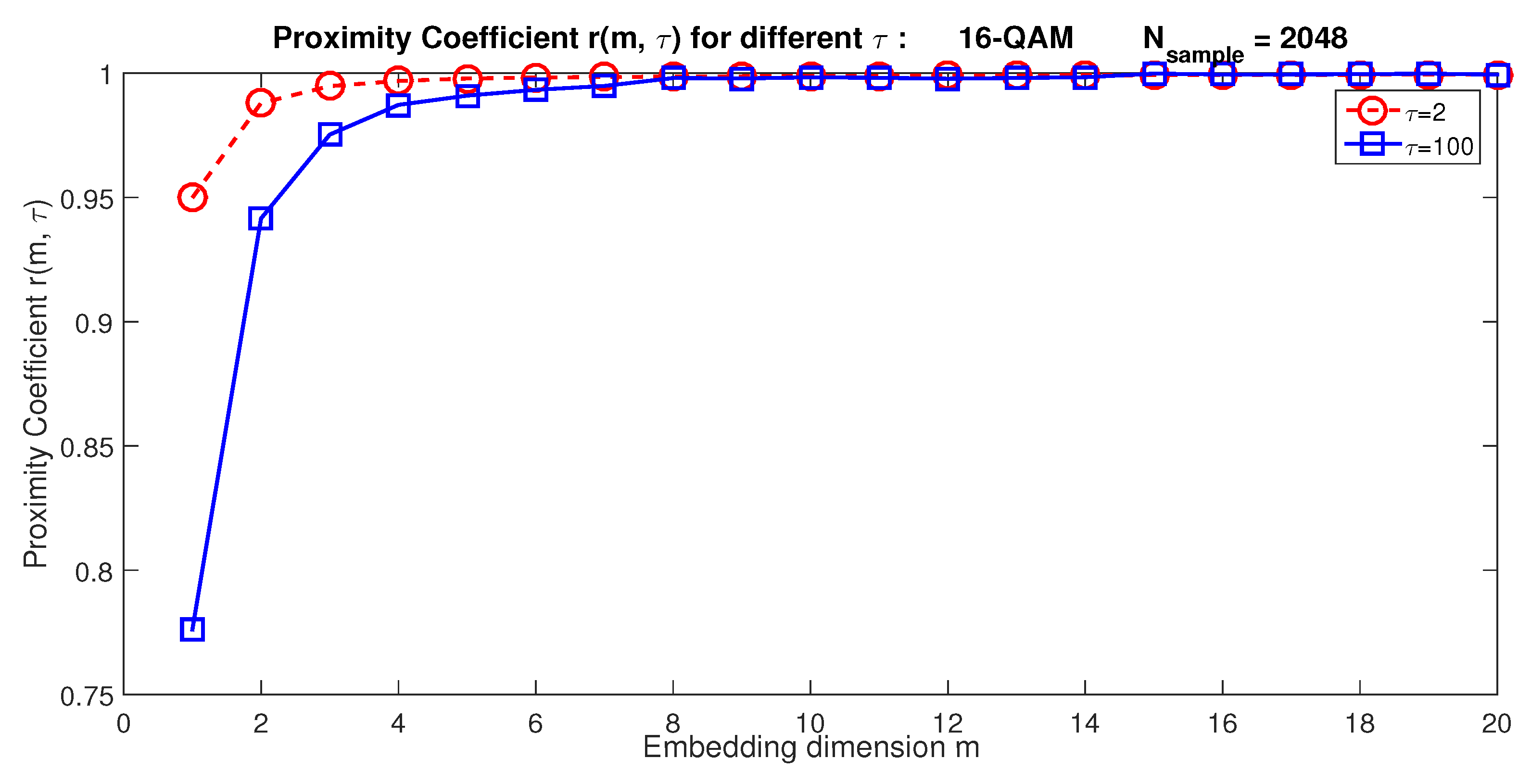
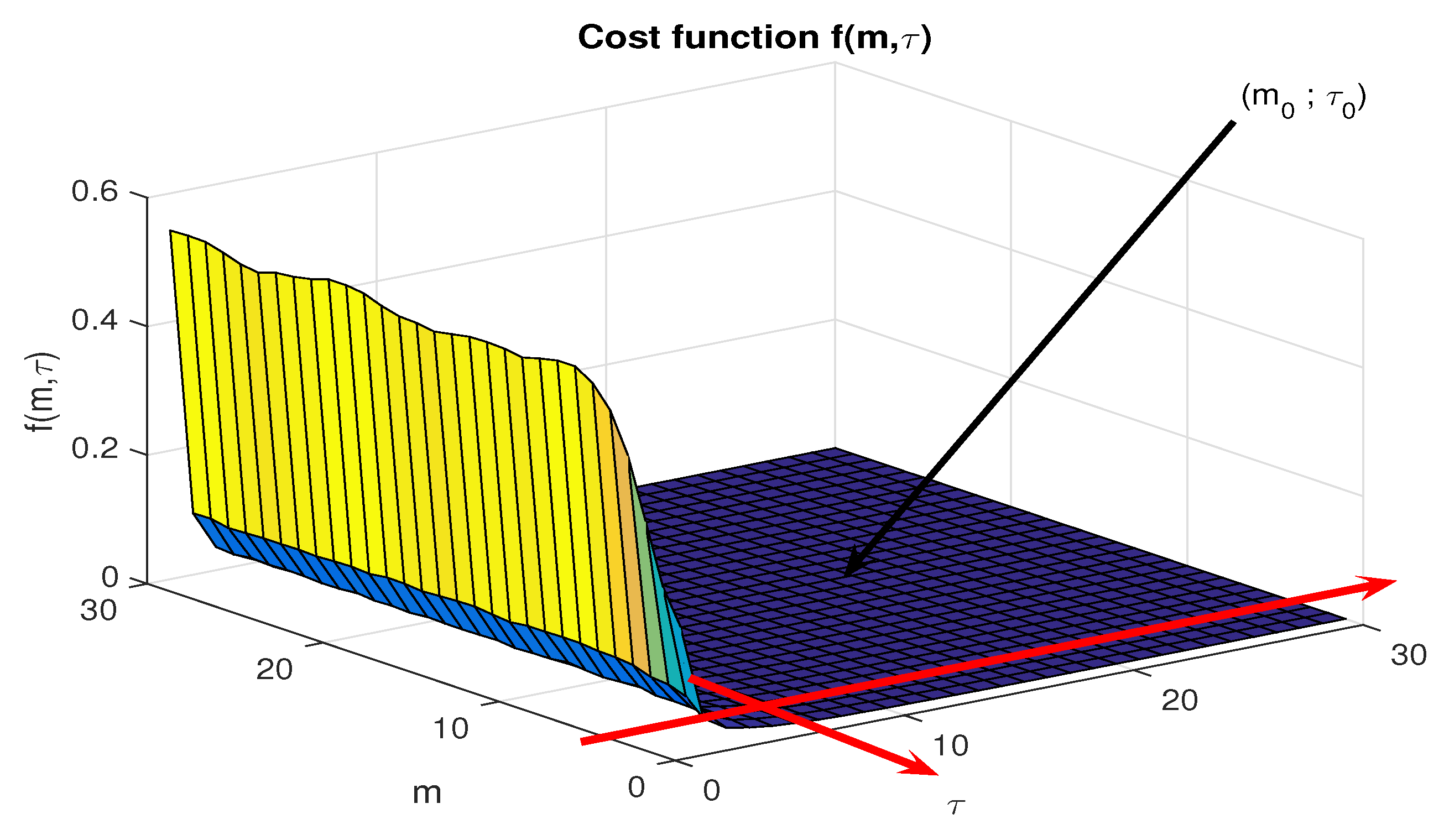
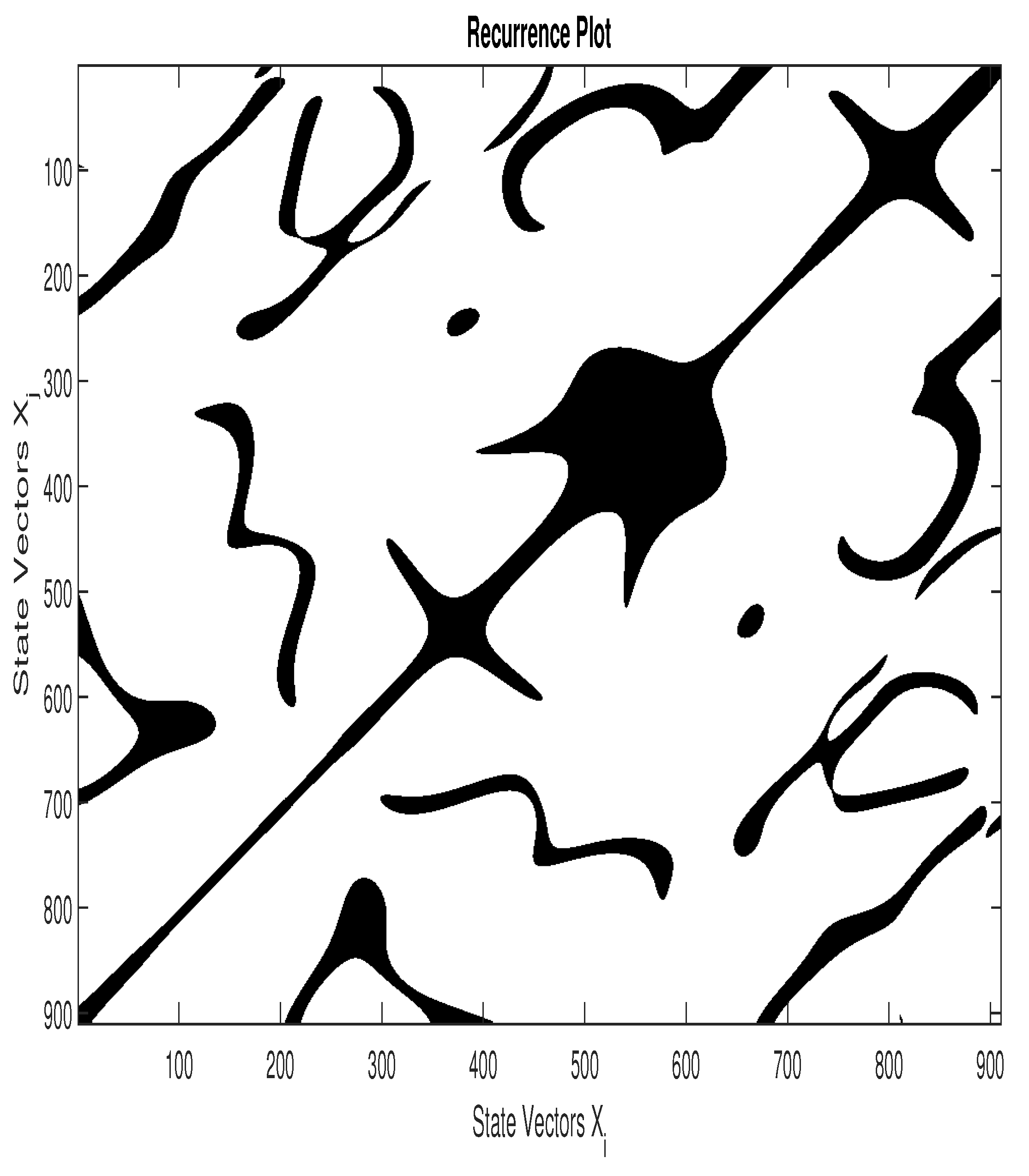
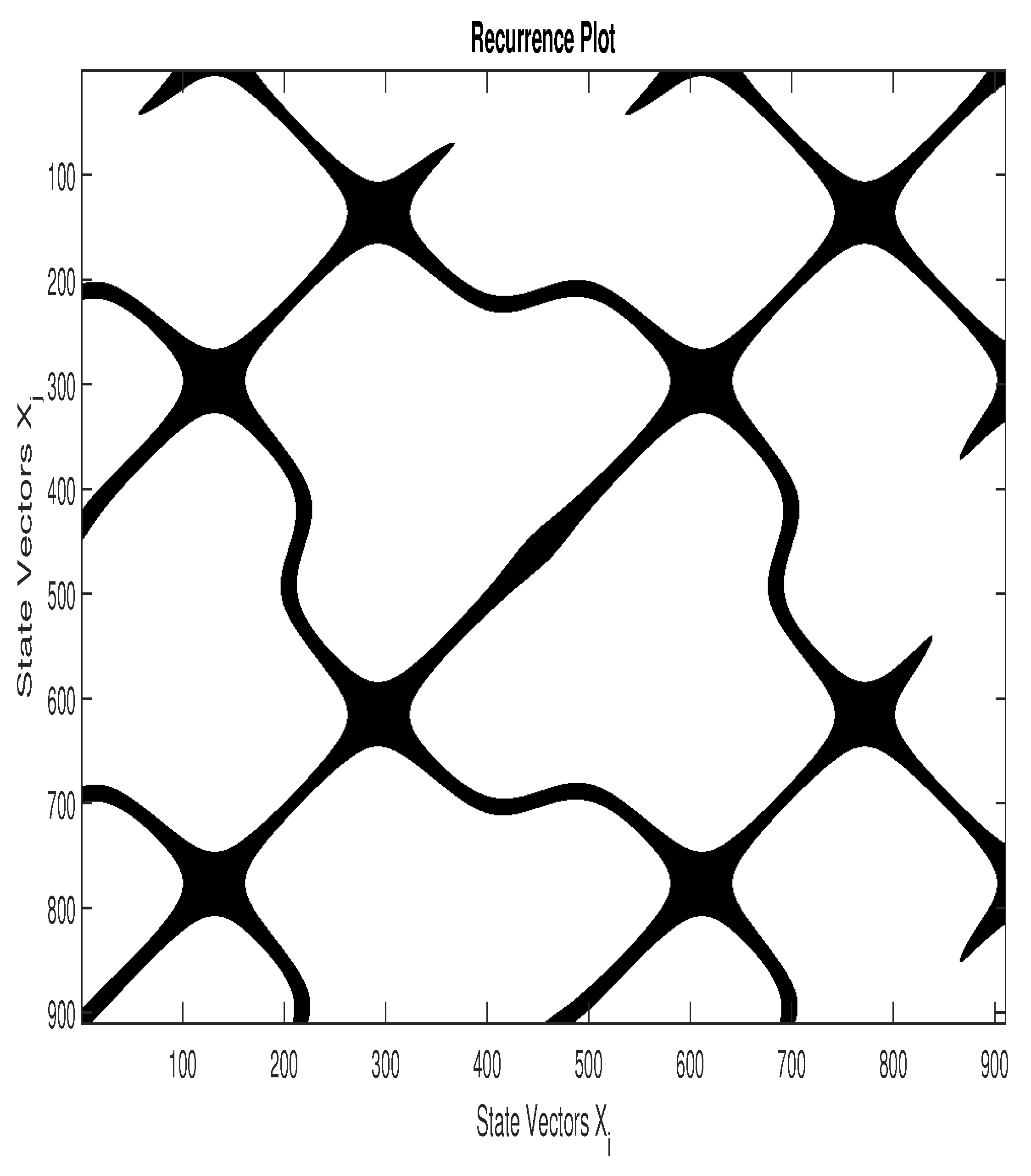
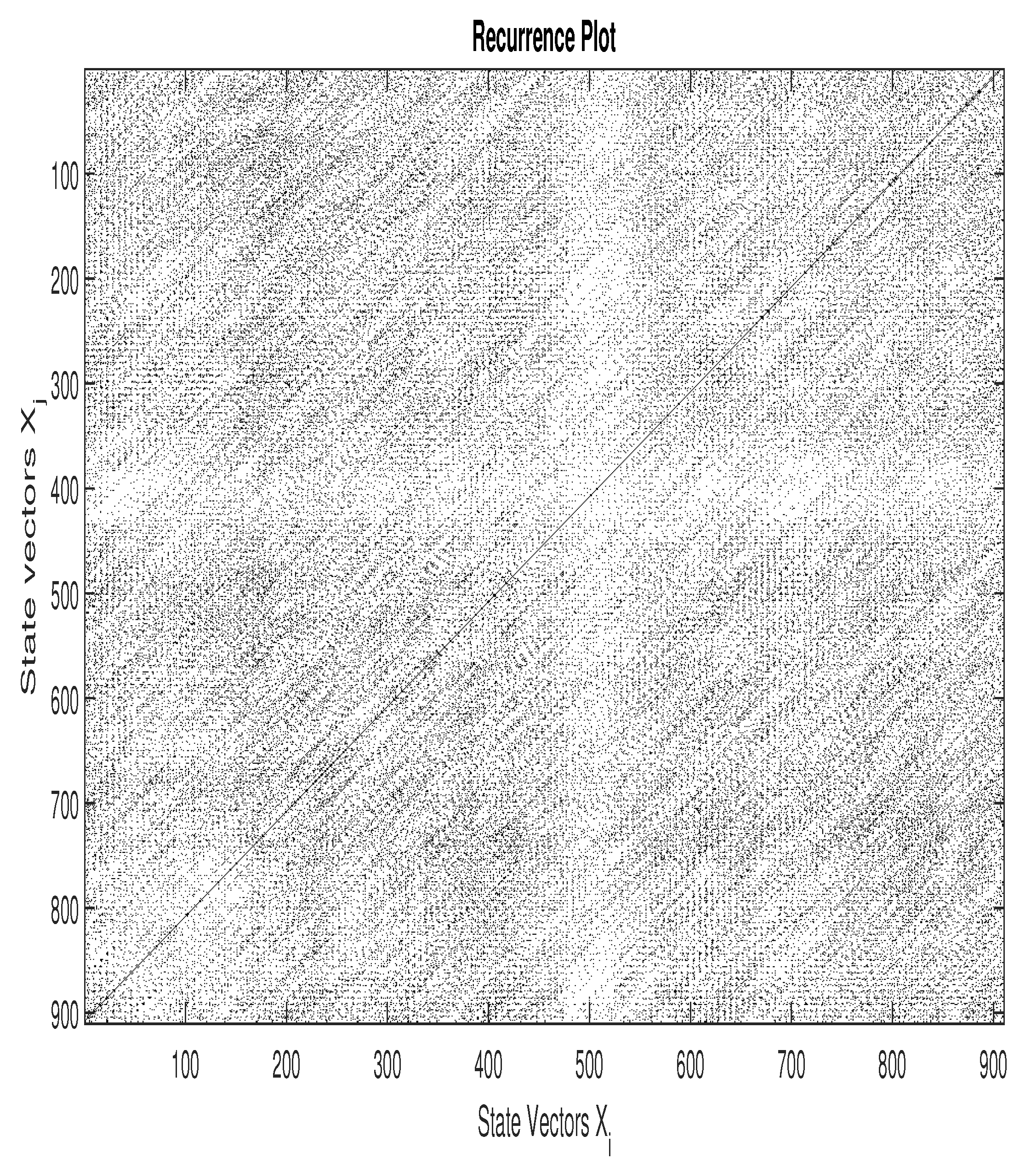
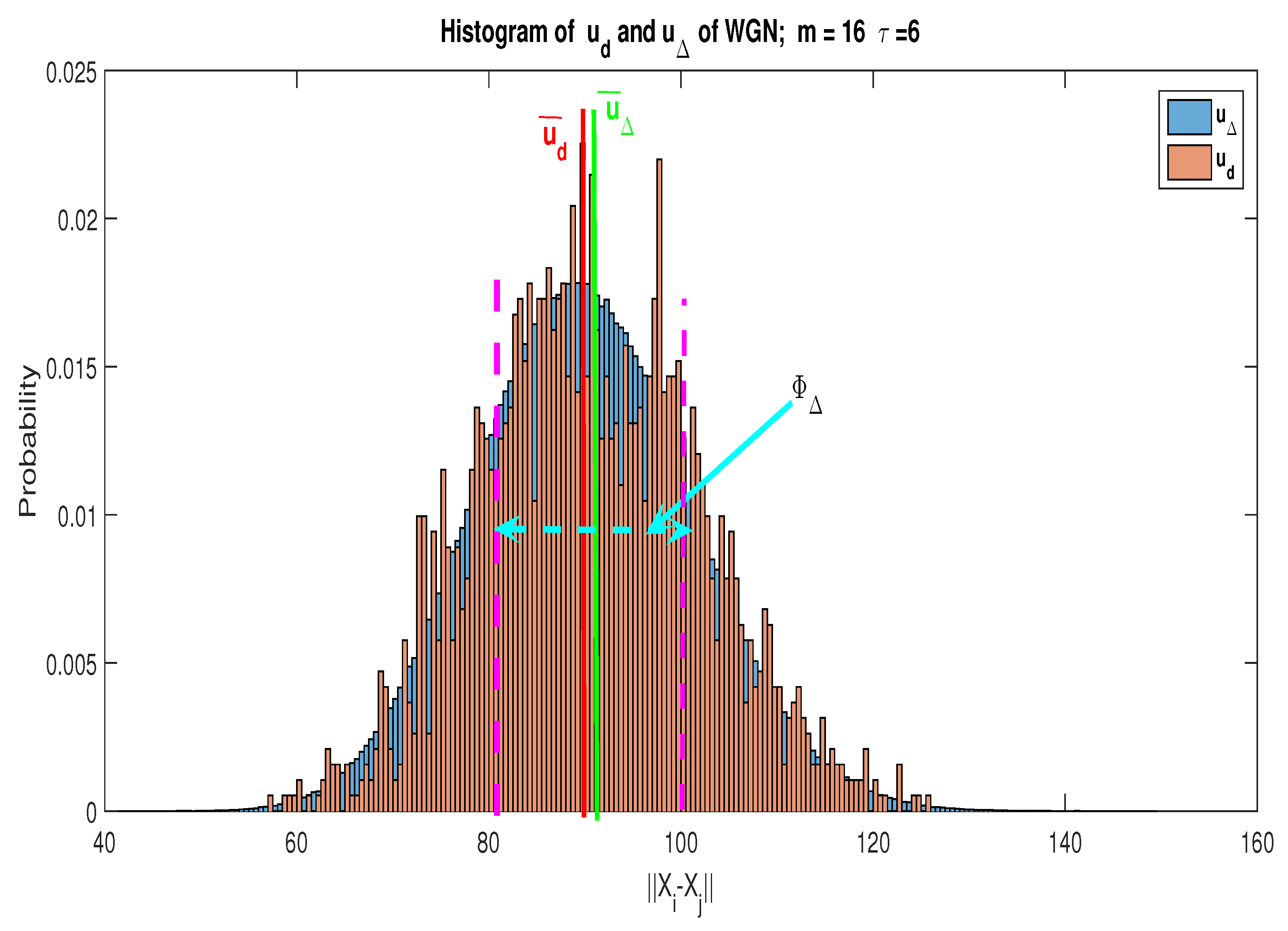
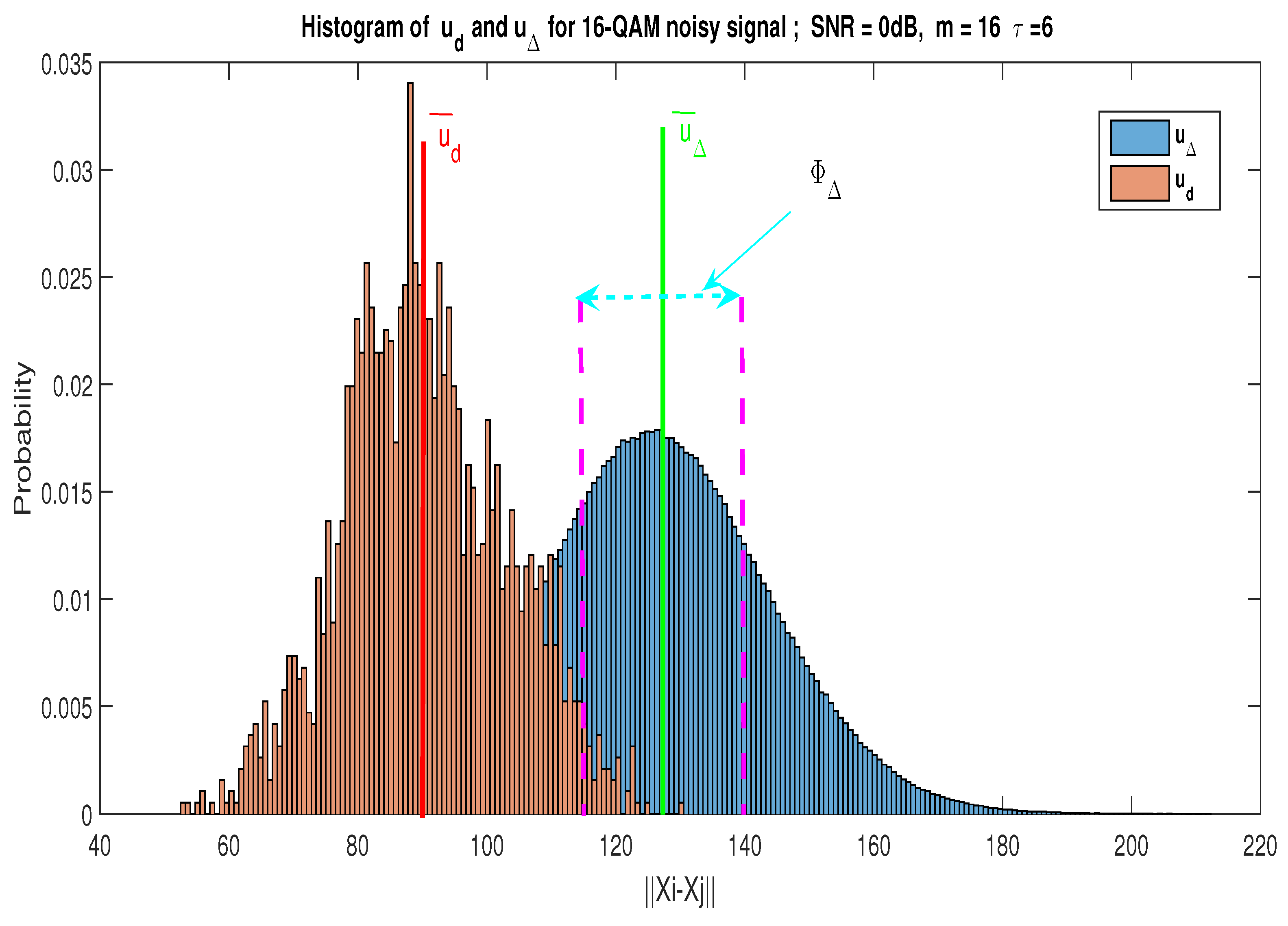
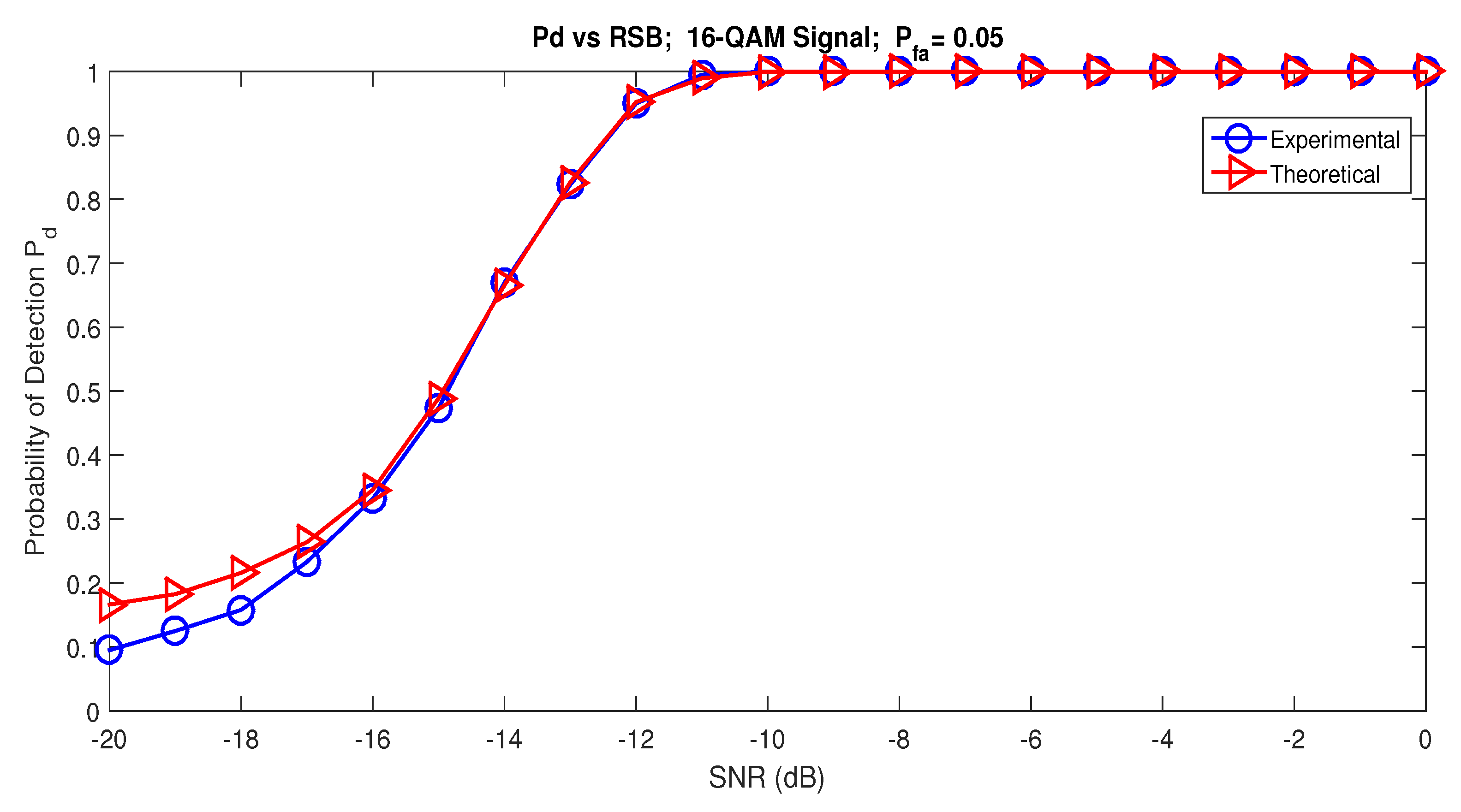
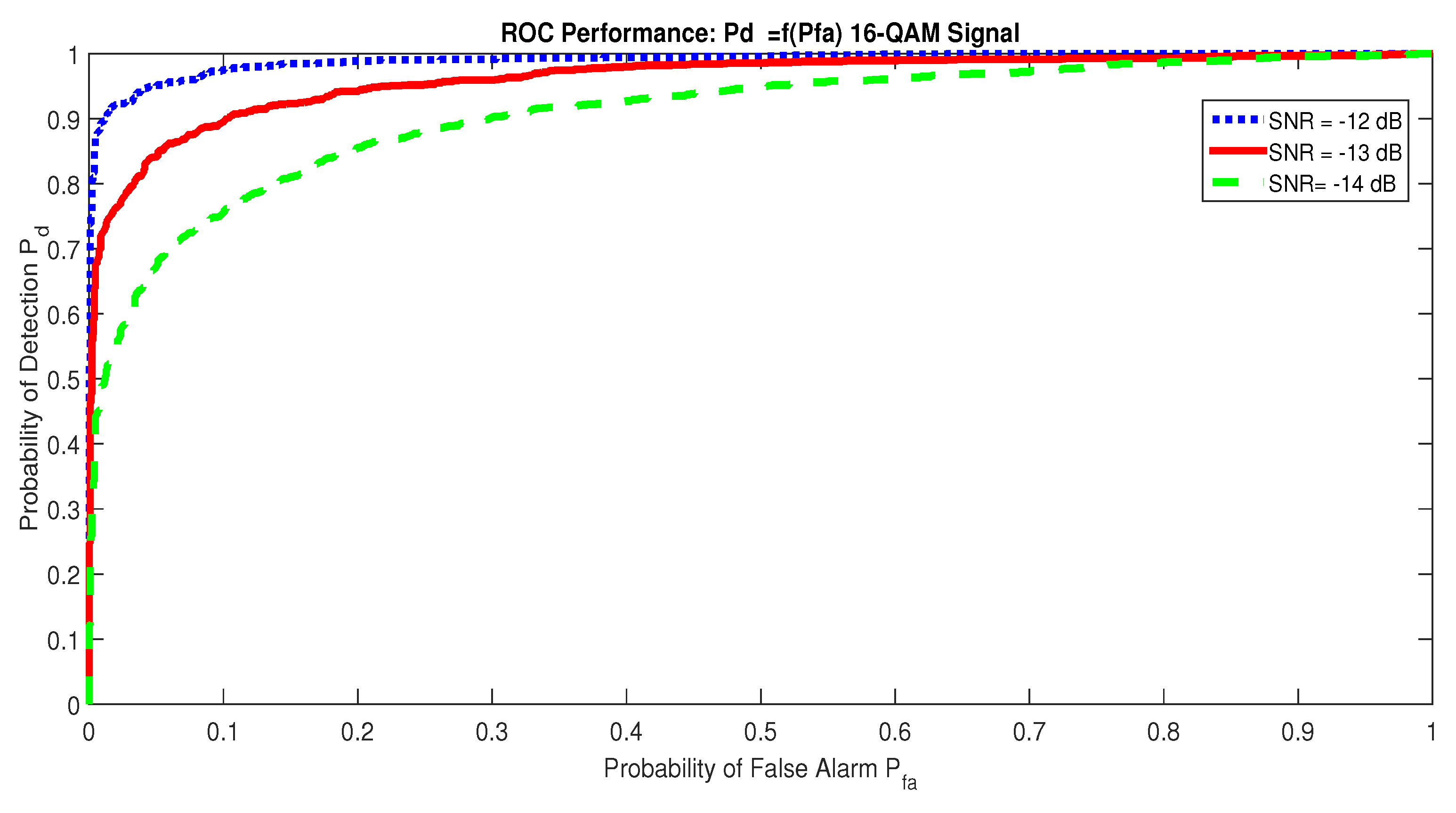
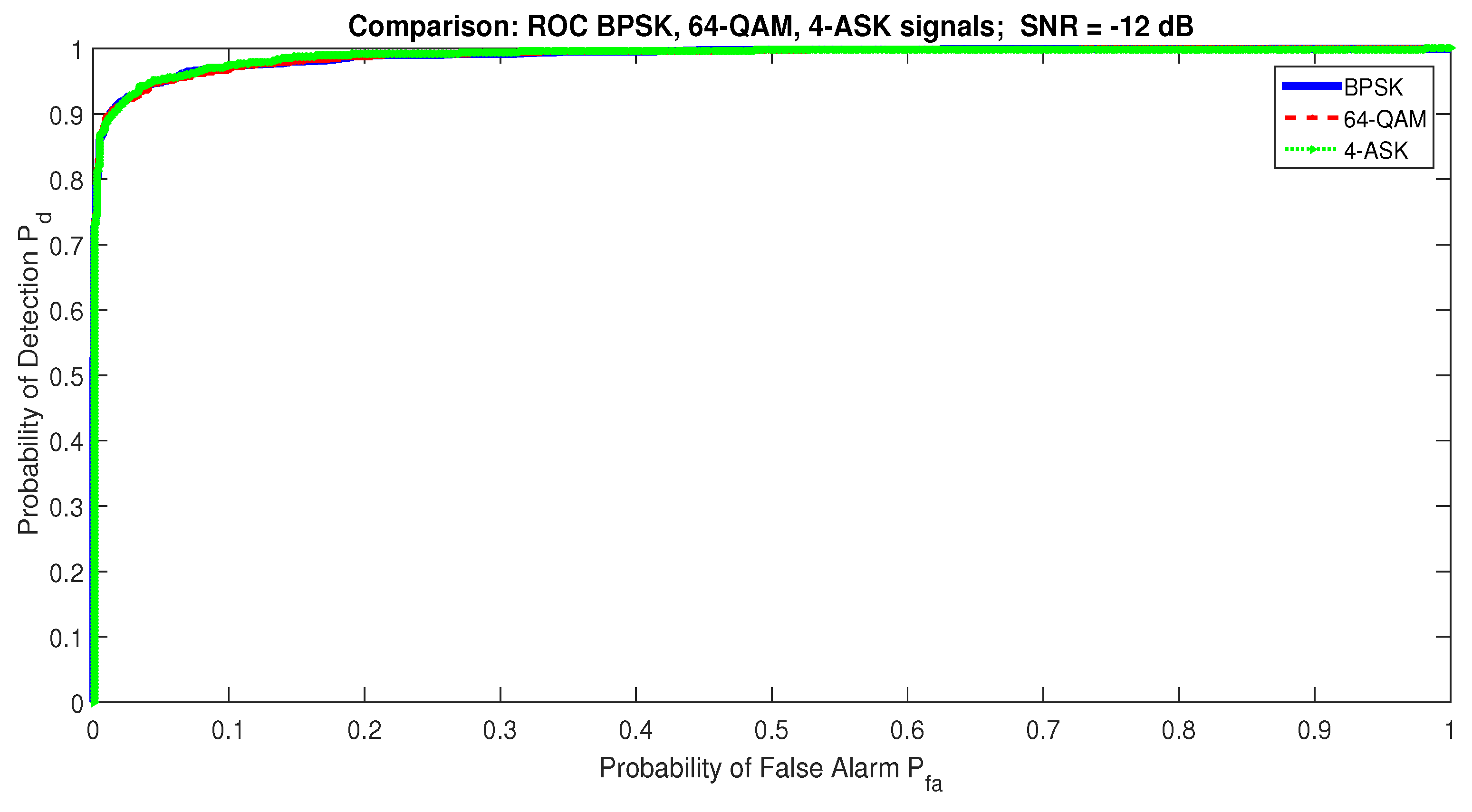
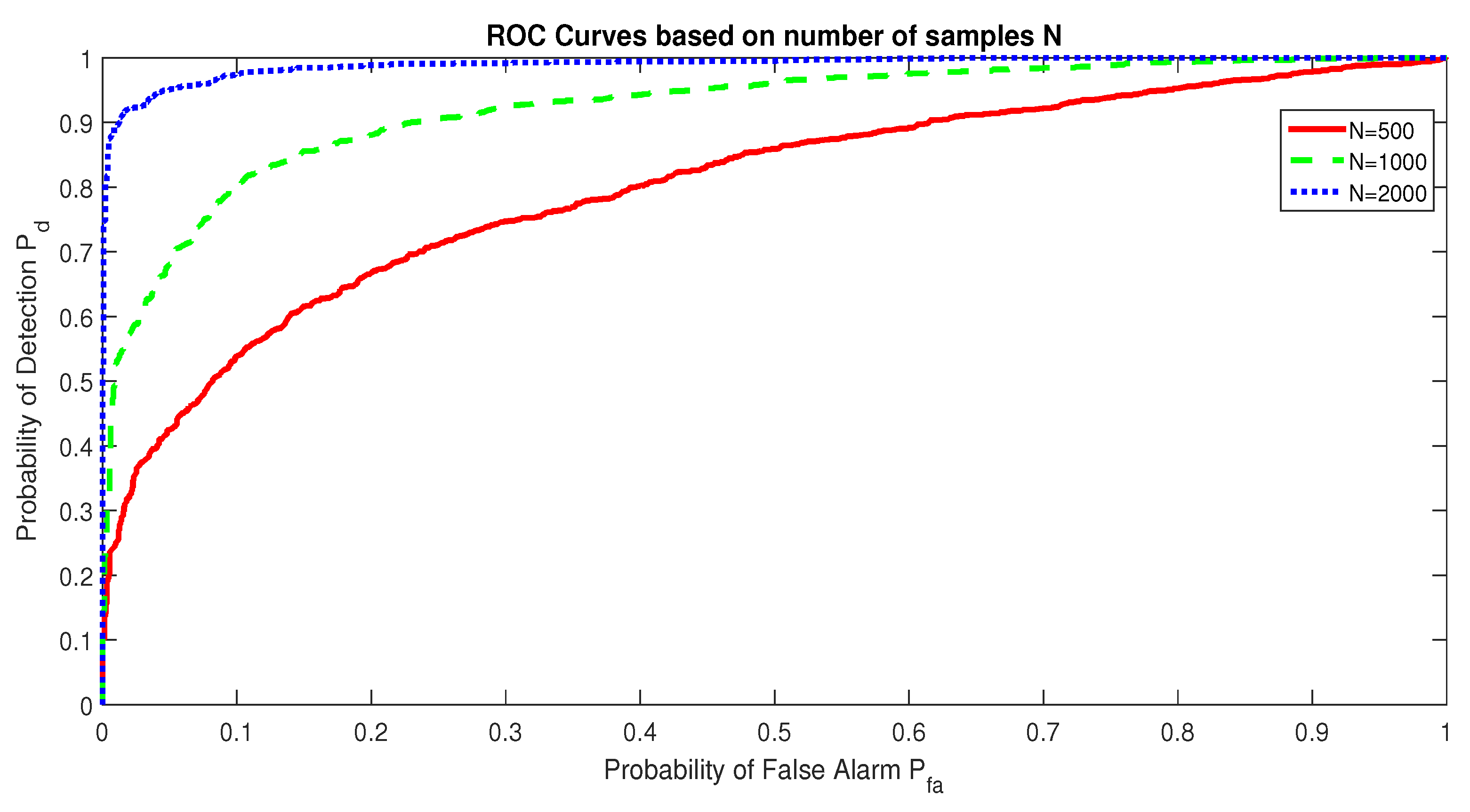
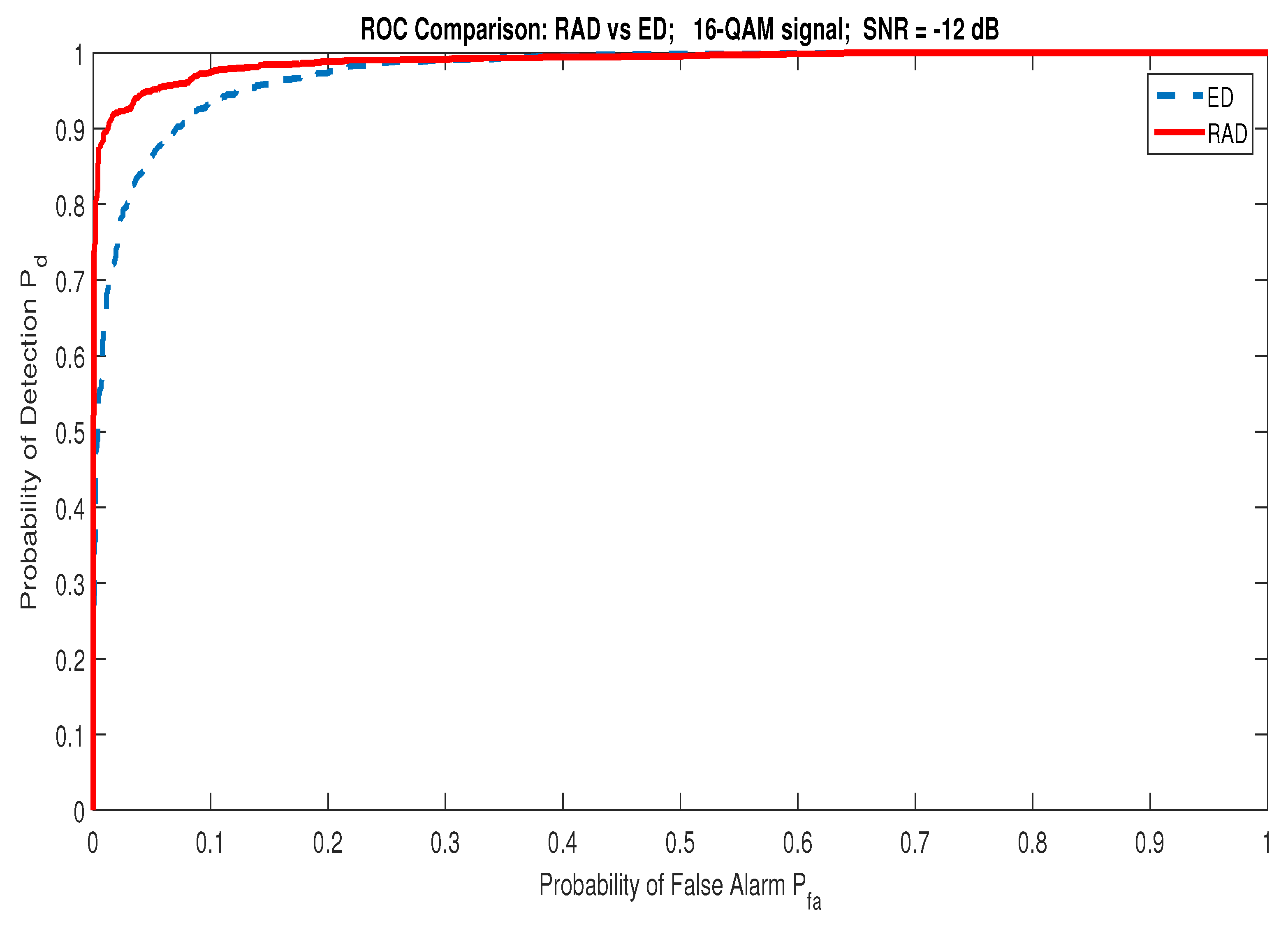
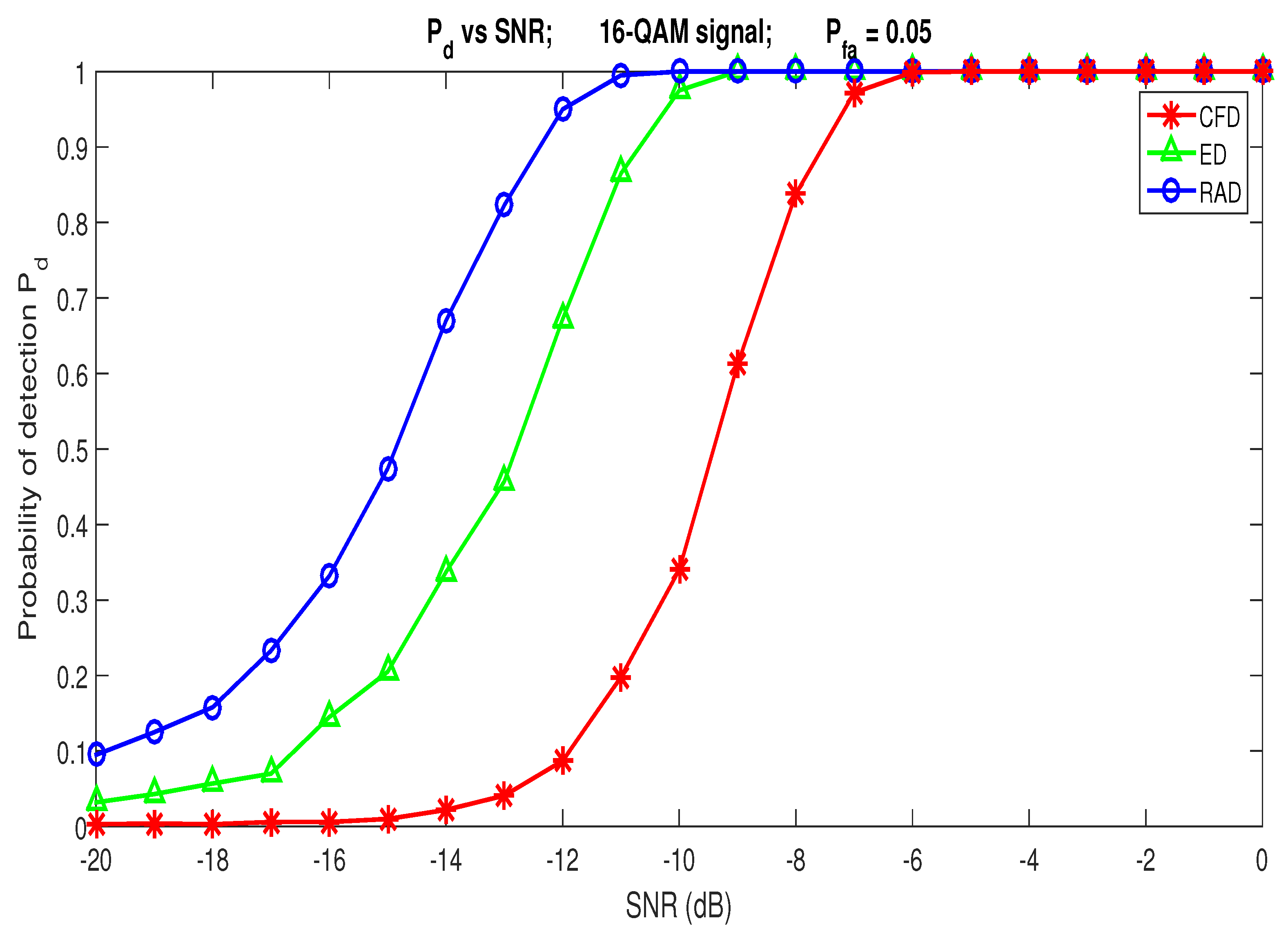
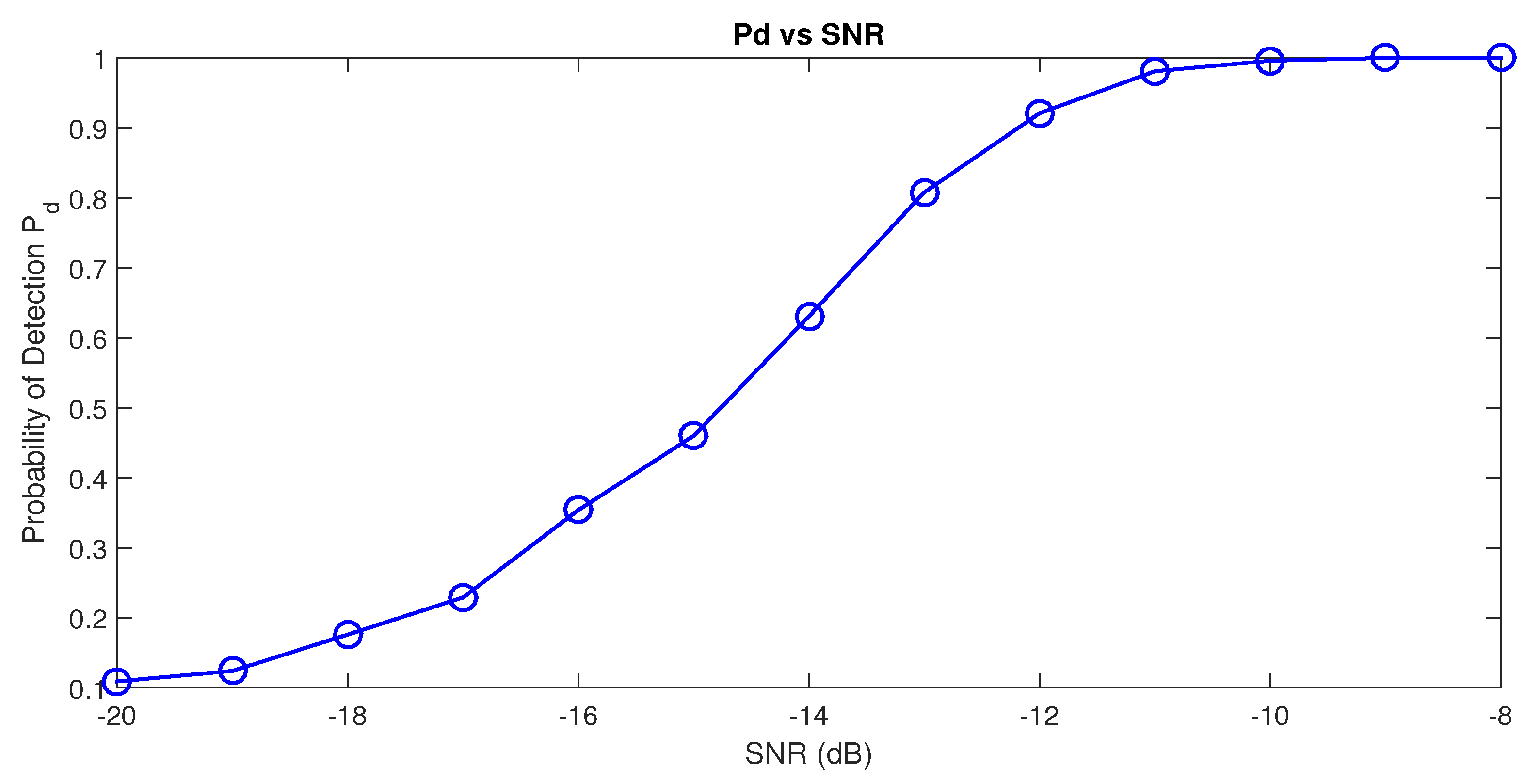

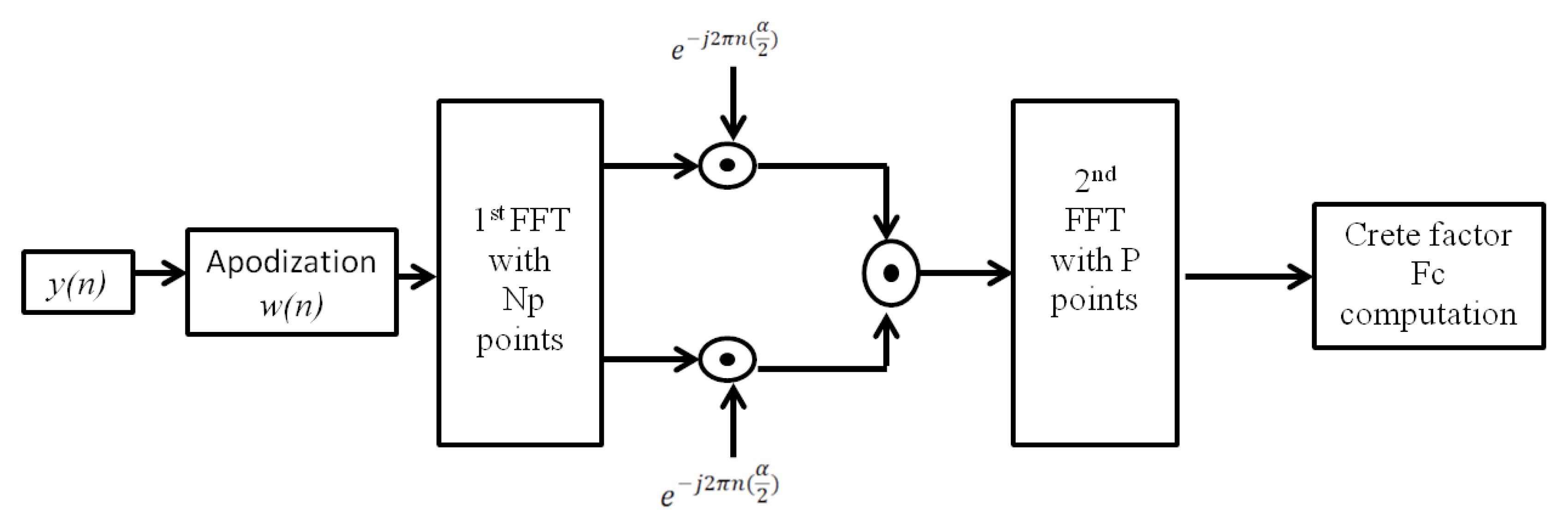

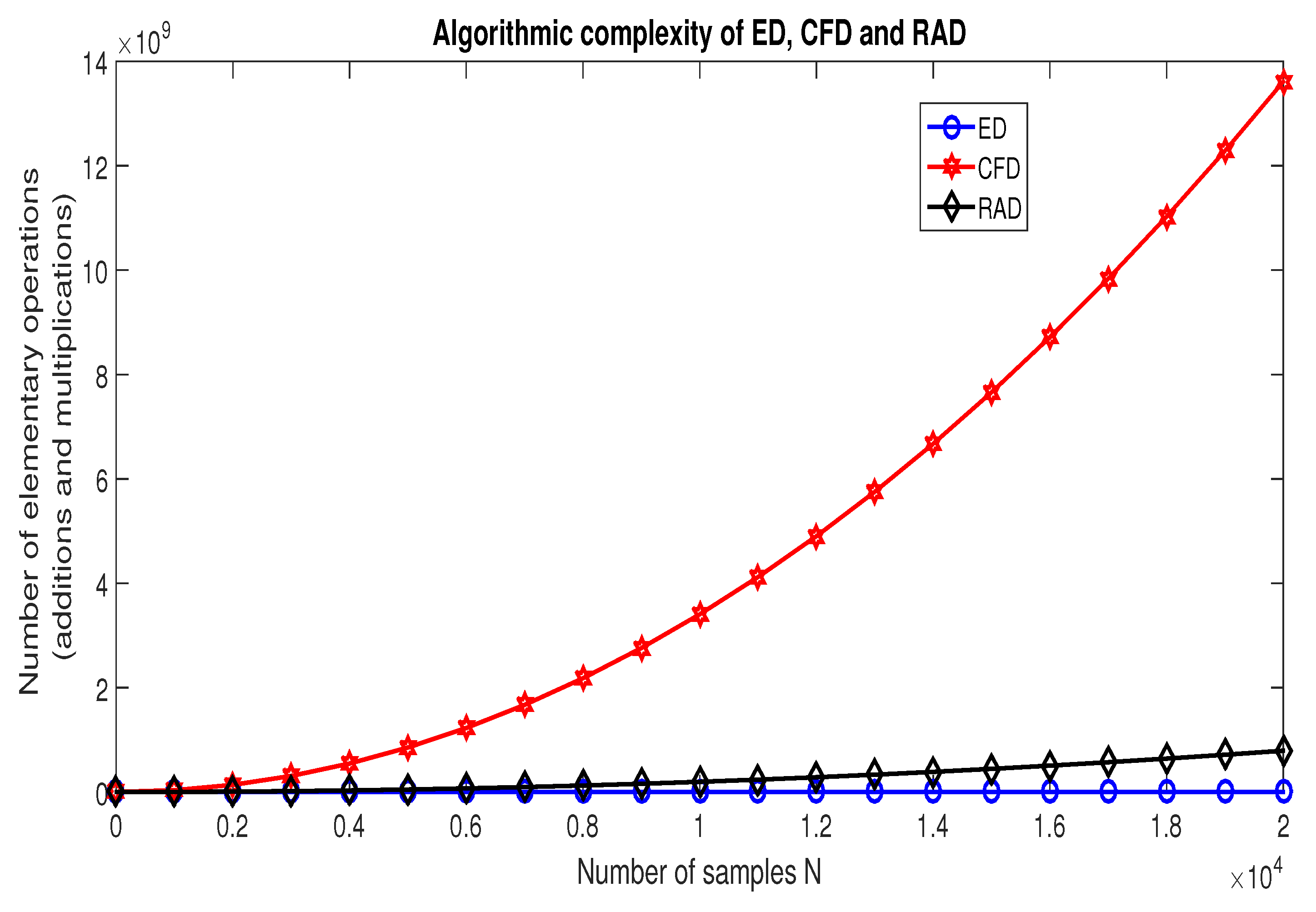
| Entity | Parameters | Value |
|---|---|---|
| PU’s signal | Sampling frequency | 128 kHz |
| Symbol frequency | 16 kHz | |
| Bandwidth of Interest B | 24 kHz | |
| SU’s Detector | Observation time | 15.6 ms |
| Samples number N | 2000 | |
| Embedding parameters | dimension m | 16 |
| time delay | 6 | |
| Transmission Channel | Noise Model | WGN |
Disclaimer/Publisher’s Note: The statements, opinions and data contained in all publications are solely those of the individual author(s) and contributor(s) and not of MDPI and/or the editor(s). MDPI and/or the editor(s) disclaim responsibility for any injury to people or property resulting from any ideas, methods, instructions or products referred to in the content. |
© 2023 by the authors. Licensee MDPI, Basel, Switzerland. This article is an open access article distributed under the terms and conditions of the Creative Commons Attribution (CC BY) license (http://creativecommons.org/licenses/by/4.0/).





